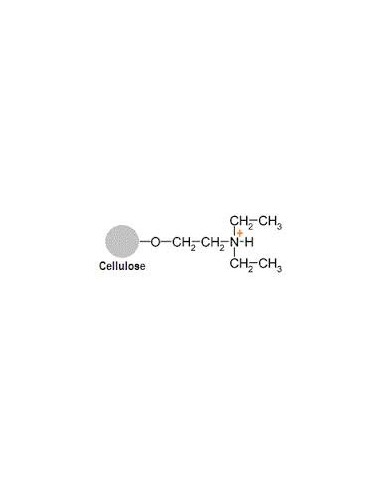DEAE Cellulose, DE52
CAS#: 9013-34-7
DEAE 52 cellulose is preswollen Diethylaminoethyl cellulose for use in anion exchange chromatography. It is a weak anion chromatography resin for separation of proteins, nucleic acids and polysaccharides.
Diethylaminoethyl Cellulose, DEAE cellulose, DEAE 52,
DEAE cellulose or DE 52 is a weak anion exchange resin of Diethylaminoethyl cellulose that is positively charges and provides high binding capacity, clean resolution. This is the prewetted providing ease of use over dry forms of DEAE cellulose. This DEAE 52 cellulose is typically used for ion-exchange chromatography of proteins and nucleic acids. The fibrous cellulose substrate is derivatized with diethylaminoethanol placing positive charges throughout the cellulose fibers. The positive charges are responsible for binding the negative charges on proteins or nucleic acids resulting in the biomolecules attaching to the DEAE cellulose. Once attached they are released from the substrate by eluting them with a buffer of high salt concentration of high pH.
Our DEAE 52 cellulose (DEAE-52) is formulated as a pre-swollen or wet product for your working convenience when performing DEAE cellulose column chromatography.
Specifications:
- Appearance: White microgranular fibrous
- Granule size: 25 - 60um
- Exchange capacity (mmol/g, dry): 0.9 - 1.4
- Water content %: 65 - 75
- Max flow rate (ml/min.): 50
- Column volume (ml/g): 6.5
- Protein loading capacity (BSA, pH 8.5, mg/g, dry): 550-900
As seen in Genetic Engineering News, New Product, Preswollen Cellulose, August 2018 issue.
Instructions for use of DEAE 52 and CM 52
Specifications for DEAE 52
Scientific citations:
-
Changes in aggregation properties and the metabolite production of probiotics following treatment with polysaccharides derived from the edible mushroom Cordyceps militaris - Science Direct -
Actin Isoform Composition and Binding Factors Fine-Tune Regulatory Impact of Mical Enzymes - International J. Mol Sci. -
Metabolic engineering of Escherichia coli... -
Method for Isolation of Myxozoan... -
Optimization of Purification Protocal for Taq DNA Polymerase used in Polymerase Chain Reaction... -
Cytoplasmic Actin: Purification and Single Molecule Assembly Assays -
Method for Isolation of Myxozoan Proliferative Stages from Fish at High Yield and Purity: An Essential Prerequisite for In Vitro, In Vivo and Genomics-Based Research Developments -
Diffusion NMR and rheology of a model polymer in bacterial cell lysate crowders
More on DEAE cellulose for ion exchange chromatography separation of proteins and nucleic acids.
DEAE cellulose is a specialized chromatography resin designed specifically for the purification and separation of proteins and nucleic acids based on their charge properties. It consists of diethylaminoethyl (DEAE) functional groups covalently attached to a cellulose matrix.
When applied to protein and nucleic acid chromatography, DEAE cellulose offers exceptional binding capacity and selectivity. It exploits the charge differences between molecules, allowing for efficient separation of positively and negatively charged species. This resin is particularly useful for separating proteins and nucleic acids with varying isoelectric points (pI) and ionic characteristics.
DEAE cellulose can be utilized in various chromatographic techniques, including column chromatography and batch purification. It is compatible with different buffer systems, enabling its use over a wide pH range. The resin's robust structure and stability enable repetitive use, making it a cost-effective solution for large-scale purification processes.
In protein chromatography, DEAE cellulose is ideal for tasks such as protein purification, isolation of specific protein fractions, and removal of contaminants. It effectively separates target proteins from complex mixtures, allowing researchers to obtain highly pure samples.
For nucleic acid chromatography, DEAE cellulose provides efficient separation and purification of DNA and RNA molecules. It aids in the removal of impurities such as proteins, enzymes, and salts, resulting in highly pure nucleic acid samples suitable for downstream applications like sequencing, PCR, and molecular cloning.
Overall, DEAE cellulose is a reliable and versatile chromatography resin for the purification and separation of proteins and nucleic acids. Its exceptional binding capacity, selectivity, and compatibility with various chromatographic techniques make it an essential tool for researchers and scientists working in molecular biology, biochemistry, and biotechnology.
TAGS diethylaminoethyl cellulose, whatman de52, deae-dextran, deae-agarose, deae sepharose, deae sephadex, deae sephacel
Cheers,
D. Raines,



